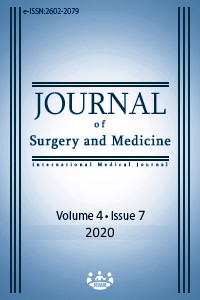Evaluation of 39 pediatric cases who underwent open and laparoscopic splenectomy: A retrospective cohort study
Keywords:
Children, Open splenectomy, Laparoscopic splenectomyAbstract
Aim: In children, aside from trauma-related splenic injury and splenic cysts, splenectomy is frequently performed in hematological diseases due to splenomegaly and thrombocytopenia. The most preferred method in children in the past years was open splenectomy. Today, laparoscopic splenectomy has become a preferred method by pediatric surgeons due to increasing laparoscopic surgical experience. The aim of this study is to present the results of the case series who underwent laparoscopic and open splenectomy in our clinic.
Methods: All patients who underwent laparoscopic and open splenectomy between 2008-2019 in our clinic were included in the study. Four ports were used in the laparoscopic splenectomy procedure and port locations differed according to patient age and spleen size. The completely liberated spleen was taken into the specimen removal bag and removed after morcellation. Open surgical method was preferred in cases where the long axis of the spleen was 200 mm or higher. Demographic data, splenectomy indications, surgical techniques and postoperative follow-up data were evaluated retrospectively.
Results: Splenectomy was performed laparoscopically in 24 of 39 patients (16 male, 23 female) and with the open method in 15 patients. Surgical indications included hereditary spherocytosis (n=15), idiopathic thrombocytopenic purpura (n=6), beta-thalassemia (n=3) in laparoscopically operated patients and hereditary spherocytosis (n=8), idiopathic thrombocytopenic purpura (n=4) and beta-thalassemia (n=3) in patients operated with the open method. Simultaneous cholecystectomy was performed in 11 cases due to cholelithiasis. The duration of the surgery was significantly longer [132 (47) and 90 (21) min., respectively P<0.001], and time until oral feeding [ 2.3 (0.8) and 3.9 (1.1) days, respectively P<0.001] as well as the length of hospitalization were significantly shorter in laparoscopic surgery compared to open surgery [3.80 (1.3) vs. 5.5 (1.2) days, respectively P<0.001].
Conclusion: Laparoscopic splenectomy is a safe method that should be preferred primarily in experienced centers for earlier feeding, shorter hospitalization times and better cosmetic results.
Downloads
References
Fachin CG, Amado F, Romaniello G, Oliveira L, Oliveira I, Wolff L, et al. Open Versus Laparoscopic Splenectomies in Children: A Comparative Study Performed at a Public Hospital in Brazil. J Laparoendosc Adv Surg Tech A. 2019;29(10):1357-61.
Shamim AA, Zafar SN, Nizam W, Zeineddin A, Ortega G, Fullum TM, et al. Laparoscopic Splenectomy for Trauma. JSLS. Oct-Dec 2018;22(4):e2018.00050. doi: 10.4293/JSLS.2018.00050.
Ates U, Tastekin NY, Gollu G, Ergun E, Yagmurlu A. Laparoscopic splenectomy in pediatric age: long-term follow-up. Arch Argent Pediatr. 2017;115(6):e385-e90.
Huang GS, Chance EA, Hileman BM, Emerick ES, Gianetti EA. Laparoscopic Splenectomy in Hemodynamically Stable Blunt Trauma. Jsls. 2017;21(2).
Moris D, Dimitriou N, Griniatsos J. Laparoscopic Splenectomy for Benign Hematological Disorders in Adults: A Systematic Review. In Vivo. 2017;31(3):291-302.
Duyuran Ö, Acıpayam C, Akkeçeci NS, Sevcan İ, Duyuran R. Etiology of anemia in children aged between 6 months and 18 years. Journal of Surgery and Medicine. 2019;3(5):402-5.
Ammori BJ. Utilization of the Falciform Ligament to Buttress the Spleen Transection Staple Line During Laparoscopic Partial Splenectomy: A Novel Technique. Surg Laparosc Endosc Percutan Tech. 2020;30(1):e1-e3.
Ouyang G, Li Y, Cai Y, Wang X, Cai H, Peng B. Laparoscopic partial splenectomy with temporary occlusion of the trunk of the splenic artery in fifty-one cases: experience at a single center. Surg Endosc. 2020 Feb 12. doi: 10.1007/s00464-020-07410-0. Online ahead of print.
Schizas D, Katsaros I, Karatza E, Kykalos S, Spartalis E, Tsourouflis G, et al. Concomitant Laparoscopic Splenectomy and Cholecystectomy: A Systematic Review of the Literature. J Laparoendosc Adv Surg Tech A. 2020.
Utria AF, Goffredo P, Keck K, Shelton JS, Shilyansky J, Hassan I. Laparoscopic Splenectomy: Has It Become the Standard Surgical Approach in Pediatric Patients? J Surg Res. 2019;240:109-14.
Targarona EM, Lima MB, Balague C, Trias M. Single-port splenectomy: Current update and controversies. J Minim Access Surg. 2011;7(1):61-4.
Deng XG, Maharjan A, Tang J, Qiu RL, Wu YH, Zhang J, et al. A modified laparoscopic splenectomy for massive splenomegaly in children with hematological disorder: a single institute retrospective clinical research. Pediatr Surg Int. 2012;28(12):1201-9.
Stringer MD, Lucas N. Thrombocytosis and portal vein thrombosis after splenectomy for paediatric haemolytic disorders: How should they be managed? J Paediatr Child Health. 2018;54(11):1184-8.
Szasz P, Ardestani A, Shoji BT, Brooks DC, Tavakkoli A. Predicting venous thrombosis in patients undergoing elective splenectomy. Surg Endosc. 2020;34(5):2191-6.
Zaharie F, Muresan MS, Tomuleasa C, Popa G. Laparoscopic splenectomy for hereditary spherocytosis. A case series and review of the literature. Ann Ital Chir. 2018;89:569-71.
Downloads
- 547 1004
Published
Issue
Section
How to Cite
License
Copyright (c) 2020 Ozgur Caglar, Binali Firinci, Agah Mansiroglu, Meriban Karadogan, Ömer Topuz, Murat Yigiter, Ahmet Salman
This work is licensed under a Creative Commons Attribution-NonCommercial-NoDerivatives 4.0 International License.
















